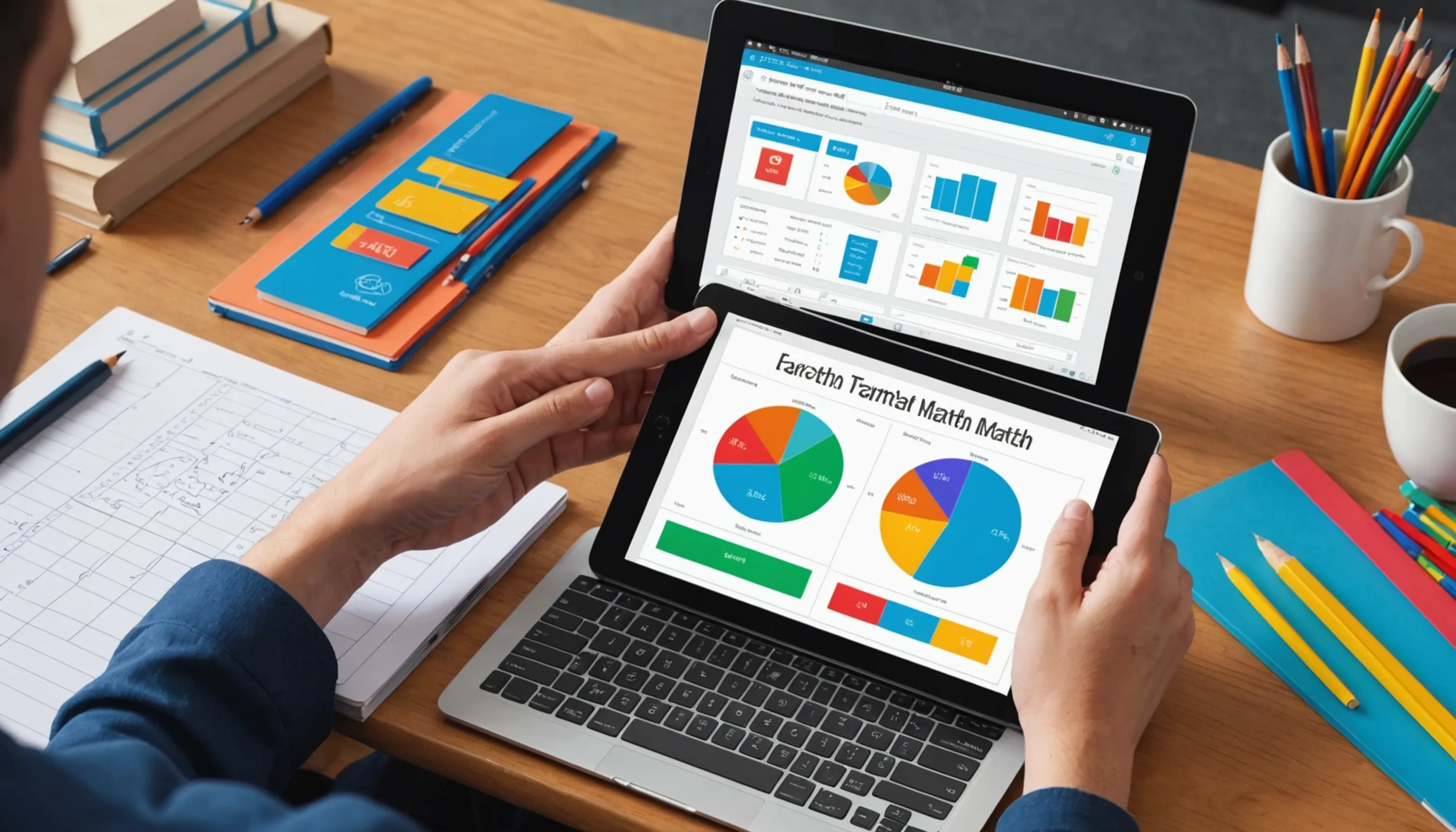How to Teach Math as a Homeschooler
 HvWHenry van Wagenberg
HvWHenry van Wagenberg
Effective Strategies for Teaching Math as a Homeschooler
Teaching math as a homeschooler can be highly rewarding when effective strategies are employed. First, it’s essential to establish a routine that includes dedicated math time, making it a priority. Use a variety of teaching methods to cater to different learning styles, such as visual aids, hands-on activities, and real-life applications. Encourage problem-solving by presenting challenges that require critical thinking.
Additionally, maintaining a positive attitude towards math helps build confidence. Celebrate small victories to motivate your teen, and always be open to adapting your approach based on their progress and feedback.
Understanding Your Teen's Learning Style
Understanding your teen's learning style is crucial for effective math instruction in a homeschooling environment. Each student has unique preferences for how they absorb and process information. Recognizing these styles can significantly enhance the learning experience.
There are three primary learning styles: visual, auditory, and kinesthetic. Visual learners benefit from diagrams, charts, and videos. Incorporating colorful visuals and mind maps into your lessons can help these students grasp mathematical concepts more easily.
Auditory learners thrive on listening and discussing. Engaging them through verbal explanations, math podcasts, or even group discussions can reinforce their understanding of complex topics. Encourage them to explain solutions aloud, which helps solidify their grasp of the material.
Kinesthetic learners prefer hands-on experiences. For these teens, consider using physical objects to demonstrate mathematical principles, such as measuring ingredients in cooking or using building blocks for geometry. Interactive activities, like math games or experiments, can also keep them engaged and enhance comprehension.
To effectively teach math, start by assessing your teen's learning style. You can use quizzes or simply observe how they respond to different teaching methods. Once you identify their preferences, tailor your lessons to include a mix of these strategies, ensuring a more personalized and effective learning experience. Remember, flexibility and patience are key as you navigate your teen's unique learning journey.
Setting Up a Structured Math Curriculum
Setting up a structured math curriculum is essential for effective homeschooling. A well-organized curriculum not only provides a roadmap for learning but also helps maintain consistency and focus. Begin by defining clear learning objectives based on your teen’s educational needs and goals. Identify the key math concepts you want them to master, such as algebra, geometry, or statistics.
Next, select appropriate resources that align with these objectives. Look for textbooks, online courses, or educational platforms that offer comprehensive math content. Ensure that the materials are engaging and suitable for your teen’s learning style. Incorporating a mix of resources, such as videos, workbooks, and interactive tools, can keep the learning experience dynamic.
Creating a weekly or monthly schedule can help structure the curriculum effectively. Allocate specific time slots for math lessons, practice exercises, and assessments. Include a variety of activities, such as problem-solving sessions and collaborative projects, to enhance understanding and retention.
Regular assessments are vital for tracking progress. Use quizzes, tests, or informal evaluations to gauge your teen’s comprehension of the material. This allows you to adjust the curriculum as needed, ensuring that they remain challenged yet supported.
Lastly, maintain open communication with your teen. Encourage them to share their thoughts on the curriculum and suggest adjustments based on their interests and learning pace. A flexible approach can foster a positive learning environment and enhance their enthusiasm for math.

Incorporating Technology in Math Learning
Incorporating technology into math learning can significantly enhance your teen's understanding and engagement. Today, numerous digital tools and resources are available that can make learning math more interactive and enjoyable. Start by exploring online platforms that offer structured math courses, tutorials, and practice problems. Websites like Khan Academy and IXL provide comprehensive lessons and exercises tailored to various skill levels.
Additionally, consider using educational apps that transform math learning into a fun experience. Apps like Photomath allow students to take pictures of math problems and receive step-by-step solutions, promoting independent learning. Other interactive apps, such as Prodigy Math, use gamification to motivate students through challenges and rewards.
Virtual manipulatives are another excellent resource. Platforms such as National Library of Virtual Manipulatives provide digital tools for exploring mathematical concepts visually, making abstract ideas more tangible. This is particularly beneficial for kinesthetic learners who thrive on hands-on experiences.
Moreover, online math games can reinforce skills while keeping your teen engaged. Websites like Coolmath Games offer a wide range of entertaining yet educational games that challenge students to apply their mathematical knowledge in different contexts.
Finally, don’t overlook the power of video tutorials. Many educators share their expertise on platforms like YouTube, covering various math topics in an accessible manner. Encourage your teen to utilize these resources to supplement their learning, ensuring they have a well-rounded approach to mastering math concepts.
Engaging Math Resources and Materials
Engaging math resources and materials are vital for capturing your teen's interest in learning. Start with interactive workbooks that provide hands-on activities and challenging problems. Incorporate manipulatives, such as blocks or counters, to help visualize mathematical concepts.
Online platforms, like Kahoot! and Quizlet, offer fun quizzes and flashcards that make learning competitive and enjoyable. Don't forget about math games, both digital and physical, which can reinforce skills in a playful way. By diversifying resources, you keep math learning fresh and exciting for your teen.
Books and Workbooks for Homeschool Math
Choosing the right books and workbooks for homeschool math is essential for fostering a solid understanding of mathematical concepts. Start by identifying resources that align with your teen’s learning level and curriculum objectives. Look for textbooks that provide clear explanations and step-by-step examples. Popular series such as Math Mammoth and Singapore Math are well-regarded for their comprehensive approach and engaging content.
In addition to textbooks, consider incorporating workbooks that offer practice exercises. These workbooks should provide a variety of problems, ranging from basic drills to more complex challenges. Resources like Teaching Textbooks and Beast Academy provide engaging practice materials that cater to different learning styles.
Don’t overlook the value of supplementary books. Math-focused novels or storybooks can make learning enjoyable and relatable. Titles like The Number Devil or Math Curse introduce mathematical concepts through storytelling, making them accessible and fun.
Additionally, consider using online platforms that offer e-books or printable resources. Websites like Teachers Pay Teachers provide a wealth of user-generated content, including worksheets and interactive lessons. These resources can be tailored to your teen's specific needs and interests.
Finally, encourage your teen to explore math-related literature, such as biographies of famous mathematicians or books that highlight the history of mathematics. This can broaden their perspective and inspire a deeper appreciation for the subject. By diversifying the range of books and workbooks used, you can create an engaging and effective math learning environment.

Online Math Tools and Apps
Online math tools and apps have revolutionized the way students learn math, making it more interactive and accessible. For homeschoolers, these resources can be invaluable in providing additional support and enhancing understanding of complex concepts. One of the most popular platforms is Khan Academy, which offers free lessons, practice exercises, and instructional videos covering a wide range of math topics. Its personalized learning dashboard allows teens to learn at their own pace and track their progress.
Another excellent resource is IXL, which provides comprehensive math practice tailored to different grade levels. The platform adapts to each student's skill level, ensuring they are challenged yet supported. With immediate feedback on performance, students can learn from their mistakes and improve over time.
For those looking to incorporate gamification into their learning, apps like Prodigy Math and Coolmath Games offer engaging ways to practice math skills through game-like environments. These platforms motivate students by transforming math practice into a fun and rewarding experience.
Additionally, consider using tools like GeoGebra for visualizing math concepts, especially in geometry and algebra. This dynamic mathematics software allows students to explore and manipulate mathematical objects, enhancing their understanding of spatial relationships.
Lastly, don’t forget about mobile apps such as Photomath, which helps students solve math problems by scanning them and providing step-by-step solutions. By integrating these online math tools and apps into your homeschool curriculum, you can create a more engaging and effective learning experience for your teen.
Interactive Math Games and Activities
Interactive math games and activities can significantly enhance your teen's learning experience by making math both fun and engaging. These resources are especially beneficial in a homeschooling environment, where traditional teaching methods might not always capture a student’s interest. Incorporating games into your math curriculum encourages active participation and helps reinforce concepts through play.
One popular option is using board games that focus on math skills. Games like Sum Swamp and Prime Climb teach addition, subtraction, and prime numbers while allowing students to enjoy friendly competition. These games promote strategic thinking and problem-solving skills.
In addition to board games, consider online platforms that offer interactive math games. Websites like ABCya and Math Playground provide a wide variety of games that cover different math topics, from basic arithmetic to more advanced concepts. These platforms often feature engaging graphics and sound effects, making learning enjoyable.
Moreover, hands-on activities can be equally effective. Try incorporating math scavenger hunts where students solve math problems to find clues or create real-life math challenges, such as budgeting for a family meal or planning a trip. This not only reinforces mathematical skills but also demonstrates the practical application of math in everyday life.
Don’t forget to involve your teen in the selection of games and activities. By allowing them to choose what they want to play or learn, you’ll foster a sense of ownership in their education, increasing their motivation and enthusiasm for math.
Assessing Progress in Math Learning
Assessing progress in math learning is essential for understanding your teen's comprehension and identifying areas that need improvement. Regular assessments help ensure that concepts are being understood and retained. Start by incorporating a variety of assessment methods, such as quizzes, tests, and informal observations.
Quizzes can be short and focused on specific topics, allowing you to gauge understanding without overwhelming your teen. Use online platforms like Quizlet to create custom quizzes that align with your curriculum. Additionally, consider using performance tasks that require your teen to apply math concepts in real-world scenarios, which can provide deeper insight into their problem-solving abilities.
Feedback is crucial in this process. After assessments, take time to review results together, discussing both strengths and areas for improvement. This dialogue not only reinforces learning but also helps your teen develop a growth mindset, encouraging them to view challenges as opportunities to learn.
Creating Effective Assessments
Creating effective assessments is a critical component of evaluating your teen's understanding of math concepts in a homeschooling environment. The goal is to design assessments that accurately reflect their knowledge and skills while providing valuable feedback for both the student and the educator.
Start by defining clear learning objectives for each math unit or topic. Understanding what you want to assess will guide the types of questions or tasks you create. For example, if your objective is to assess algebraic problem-solving skills, include a range of questions that require applying those skills in different contexts.
Incorporate various question formats to keep assessments engaging. Use multiple-choice questions for quick checks of understanding, while open-ended questions encourage critical thinking and deeper explanations. Performance tasks can also be effective, allowing students to demonstrate their understanding through projects or real-world applications.
Additionally, consider integrating self-assessment and peer assessment into your process. Encouraging your teen to reflect on their own work fosters self-awareness and responsibility for their learning. Peer assessments can provide different perspectives and promote collaboration.
Finally, ensure that assessments are spaced throughout the learning process. Frequent, low-stakes assessments can help track progress and reduce anxiety. After each assessment, provide constructive feedback that highlights strengths and suggests areas for improvement. This not only aids in learning but also motivates your teen to engage more deeply with the material.
Using Feedback to Improve Understanding
Using feedback effectively is essential for improving your teen's understanding of math concepts. Feedback serves as a guiding tool, helping students recognize their strengths and identify areas that need improvement. Here are some strategies to maximize the effectiveness of feedback:
- Timely Feedback: Provide feedback as soon as possible after assessments or assignments. This immediacy helps reinforce concepts while they are still fresh in your teen's mind.
- Specificity: Instead of vague comments like "good job" or "needs work," offer specific insights. For example, highlight which problems were done correctly and explain why certain mistakes occurred.
- Encourage Self-Reflection: After providing feedback, ask your teen to reflect on their performance. Questions like "What did you find challenging?" or "How can you approach this problem differently next time?" promote critical thinking and self-awareness.
Additionally, consider using peer feedback as a valuable resource. Encourage your teen to discuss their work with a study partner or sibling. This collaborative approach can provide different perspectives and enhance understanding.
Moreover, create an open dialogue about feedback. Ensure your teen feels comfortable discussing their thoughts on the feedback received. This conversation can lead to deeper insights and foster a growth mindset, encouraging them to view challenges as opportunities for improvement.
By utilizing feedback strategically, you can help your teen build confidence and mastery in math, paving the way for continued success in their learning journey.
